.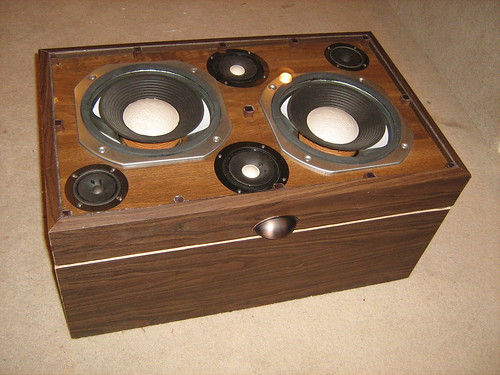
What follows is the first in what will likely be a disjointed 3 or 4 part series focussed on making stuff out of speakers (I have 4 speakers available to mess around with, but I'll probably royally screw up on at least one of them). If you've got access to a circular saw, repurposing speakers is a REALLY easy thing to do, and the end results are pretty superb, if I do say so myself (and I will). And with that, we shall begin...
Necessary Materials:
- A speaker/common sense
- Circular saw
- Hinges (and any other accessories like handles or corner guards that you want to adorn your precious trunk with)
- Sheet of plexiglass (optional)
- Strong adhesive
- Gumption
TIME TO COMPLETE: If you work straight through and don't paint the inside, you could finish it in a couple of hours. If you paint the inside and opt into taking numerous day long ass scratching retreats (as I did), it'll take you about a week.
Instructions:
I found the speaker I used for this project (and another one just like it) through a guy on craigslist, who was willing to part with these fine pieces of broken audio equipment for the price of "free". While they were no longer capable of producing pleasant sounds, visually they were still pretty striking, and all of the corners and side panels were clean and free of dents and significant scratches, so I took him up on his offer. If given a similar opportunity, I would encourage you to do the same.
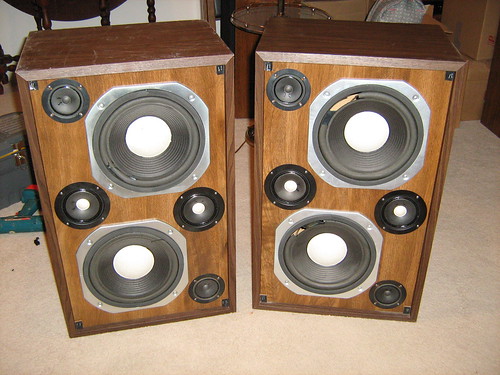
1. The first thing you need to do when modifying a speaker box is remove the actual speakers from the speaker box (someone help me, I can't figure out how to make this sentence not sound horrible). After unscrewing them, and carefully placing the often oddly sized screws in some sort of a receptacle for later use, just pull the speakers out of the speaker box and cut them free of any wires that they may be connected to. Once all of your speakers are out of the box, reach inside and remove (either by cutting or caveman-esque yanking) the wires inside.
2. (optional) You're done with step one of your venture, so if you have one available, grab a red delicious apple and shine it on your shirt before taking a hearty bite out of it, then smile obnoxiously to convey your newfound sense of self satisfaction to any passers by.
3. Get out a ruler (or a t-square, if you're certifiably bourgeois) and mark an even line around the outside of your speaker box, separating what will become your trunk's lid from its base. I'd personally suggest making your lid extend down a little bit farther than the cone on your biggest speaker, but that choice is entirely up to you.
4. Bust out your handy dandy circular saw (a table saw would work better, if you have access to one) and cut along your line on all sides, removing your lid from your base like-a so:
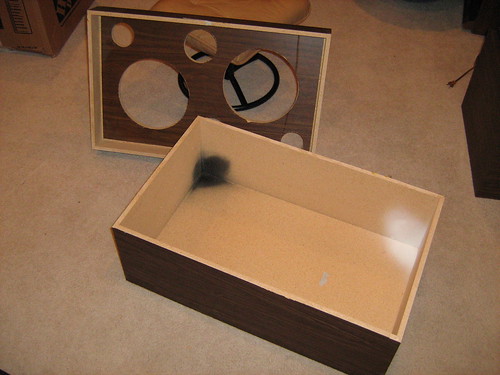
5. This was actually my first time using a circular saw, so I made a few decent sized errors, but I just remedied those with epoxy putty and creative sanding. If you made the same errors, I'd suggest taking the same courses of action. Otherwise, just sand the edges that you've just cut to make them nice and smooth, like the nape of Ted Danson's neck.
6. (somewhat optional) Paint the inside of your soon to be trunk, as almost all speakers are made out of particle board, the most hideous form of lumber known to man. I used spray paint on mine, but if I had the chance to do this over again I'd just use good old fashioned bucket-based paint. It was way too hard to get anything resembling an even color with rattle cans.
7. Once your optional paint has dried, you're going to want to modify your speakers a little bit before putting them back in their proper places. The back end of any speaker is going to have a large circle of metal on it that's wrapped with a magnet - it sort of looks like a hockey puck from the set of Mad Max: Beyond Thunderdome. Some speakers will have yet another magnet disk on the back of that first hockey puck thing. Anyway, these magnet apparatuses often weigh upwards of 5lbs a piece, so getting them out of the picture will make opening and closing your trunk a much easier task (not to mention the fact that once you remove them, you'll actually be able to store metal objects in your awesome box - that's a definite bonus).
All of the magnet disks that I've encountered have been held on by glue as well as 4 stubby pins that rest in 4 holes in the back of the speaker and keep the magnet in its proper place (similar to how a tire fits onto the axle of a car, if you've ever had to fix a flat). The pins aren't threaded or welded into anything, so all you need to do to dislodge this disk is break the hold of the glue that's keeping it in place. Take a chisel, line it up right on the seam between the speaker and the magnet, and hammer it through until it's an inch or so beneath the disk, then pull it out and repeat this action in different spots around the disk until it eventually pops off. Once you've gotten used to how it works, it'll only take you a couple of seconds to be rid of one of these things. Good riddance, I say.
Note: In all likelihood, you WILL run into the stubby metal pins with your chisel when you do this, and those pins will almost certainly leave a few dings in your chisel to show for it, so use a crappy chisel if you have one available.
8. If there is any superficial damage to the speakers themselves that needs to be repaired, this would be a good time to do it. The outermost foam ring on the speakers I had, for example, were dried out beyond belief. You'd just touch them and they'd crumble away, sort of like Kirk Douglas' face, so I chose to cut off that outermost ring leaving only the inner rings that were backed by a plastic cone. You can see a before and after shot below:
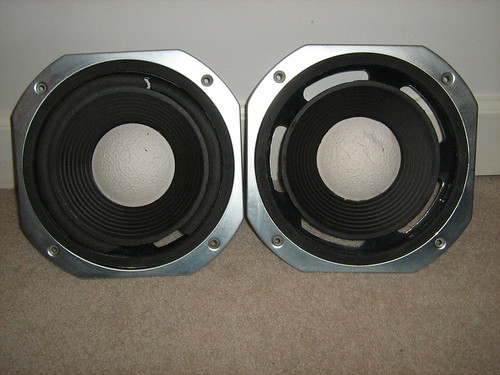
9. Put your trunk lid back on its base, making sure that the sides line up properly (if you made any errors with your circular saw cuts, you'll want to make sure that the box fits back together just like it did before you sliced the box in half). Once everything's fitting together all fancy-like, attach your hinges to whichever side you want them on, though you may need to bevel the seam they're covering to make them fit just right (as you can see from the pictures, I beveled the edges around my whole speaker box, but that was primarily done to mask some of the cutting miscues I'd made).
10. Put your speakers back in their places, screw them back in with the screws you set aside earlier, and that's it. If you're pleased with the trunk that lies before you, then you're done. If you'd like to make it a little fancier, then we've got a couple more steps left to grapple with.
11. You're probably going to want to add a couple more accessories to the outside of your trunk, most notably a handle. If you're handy with a jigsaw, you could just cut a finger hold out of the lid, but I opted to just put a handle I found at the Home Despot on there. At some point I'd also like to put two drawbolt latches on the outside of mine, but I have no idea where those things could be bought (and I'd like to match their color to that of the handle that I already have on there, so buying them off the internet is a pretty piss poor option). You could also put some corner guards around your base to make your trunk a little more durable, but I couldn't find any for less than $5 a pop, which is well out of my price range for something that's not completely necessary. Handles on the sides for carrying your trunk might be a nice touch too, but I'm opting out of that, at least for the time being.
12. If you want to protect your speakers from future damage, you're going to need to put them under glass or plexiglass, which is going to cost you anywhere between $10 and $40, depending on the size of your speaker and the quality of the glass/plexiglass that you decide to use (plexiglass usually comes in 3 thicknesses, I would recommend against getting the thinnest stuff available, as you'll likely never get it to retain a flat surface). Important note: Plexiglass is NOT easy to cut, in fact it's an absolutely astounding pain in the ass, so unless your speaker just happens to be the EXACT size of one of the precut sheets they have at the Home Despot, you're going to want to go to a hardware store or glass shop that will custom cut materials for you.
Every set of speakers is going to be a little different from every other set of speakers out there, so I can't describe exactly what you'll need to do to mount plexiglass over your lid, but I'm sure you'll figure something out. For mine, I just measured the distance between the base of my speaker facade and 1/4" (the depth of my plexiglass) below the rim of the retaining wall surrounding it. I then cut out 13 small pegs of that length out of a cheap wooden rod and glued them into place as support trusses around the rim and inside of my speaker space:
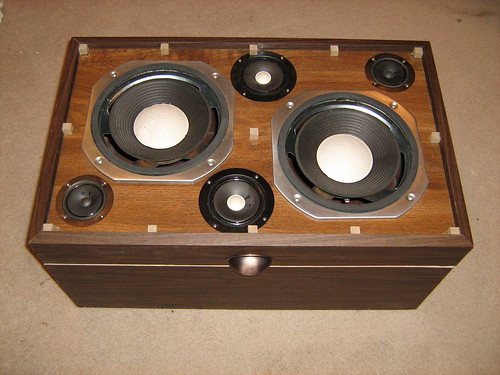
13. After that I just stained those pegs to match the fake wood finish of the speaker box, then glued and sealed my plexiglass sheet into place with silicone glue, which is a rubbery glue commonly used to seal seams in aquariums (feels a lot like those booger-ish globs that you'll occasionally find stuck to the back of catalogs). I used silicone for this for a couple of reasons: First, it's clear, so it's not going to detract much from the look of your finished product, but it can also be removed without damaging any of the surfaces it was adhered to, so if at some point your plexiglass gets cracked, or a bunch of dirt somehow ends up behind your plexiglass, you can remove/replace the surface without having to replace the wood beneath it as well. To summarize: Silicone glue - it's good shit.
14. If there are any holes in your speakers that could allow dirt to pass between the inside of your trunk and the underside of your plexiglass, you're going to want to seal those up. If it's something as simple as a punched hole in one of the speaker's cones, some electrical tape will probably do the job just fine. On mine, as I had removed the outer ring from both of my speakers, I had to cover up the whole backside of the speaker cones with packing tape and card stock paper, but it came out looking just fine. "How fine", you ask?

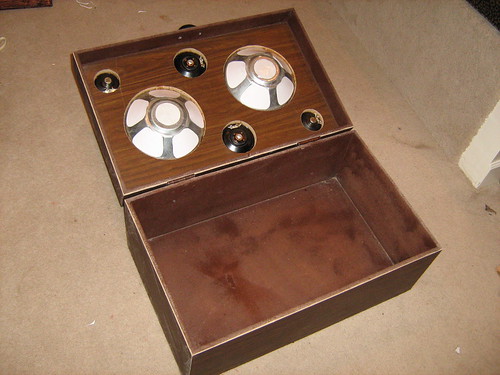
That fine, mutha facka.
Tune in next time when I'll show you how to stop the spread of herpes with used grocery bags.





1 comment:
Thanks so much for this article, pretty useful material.
Post a Comment